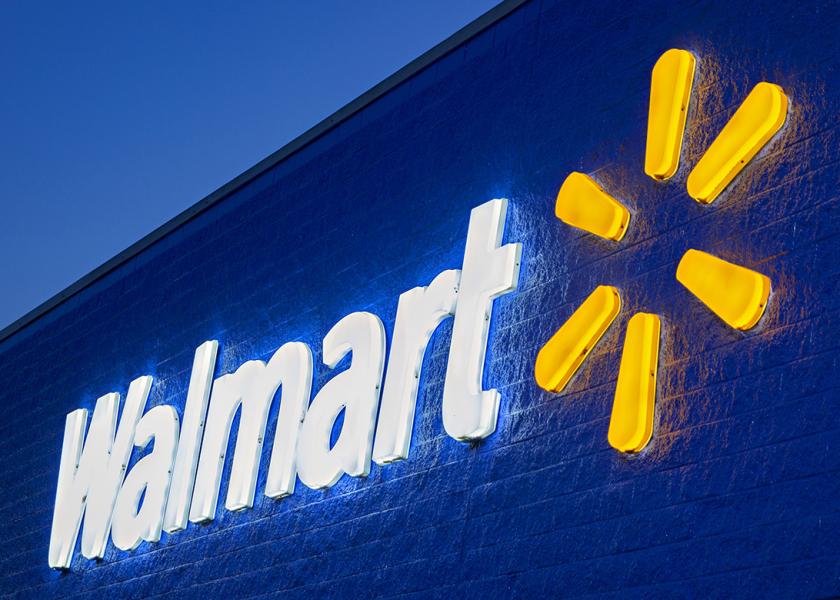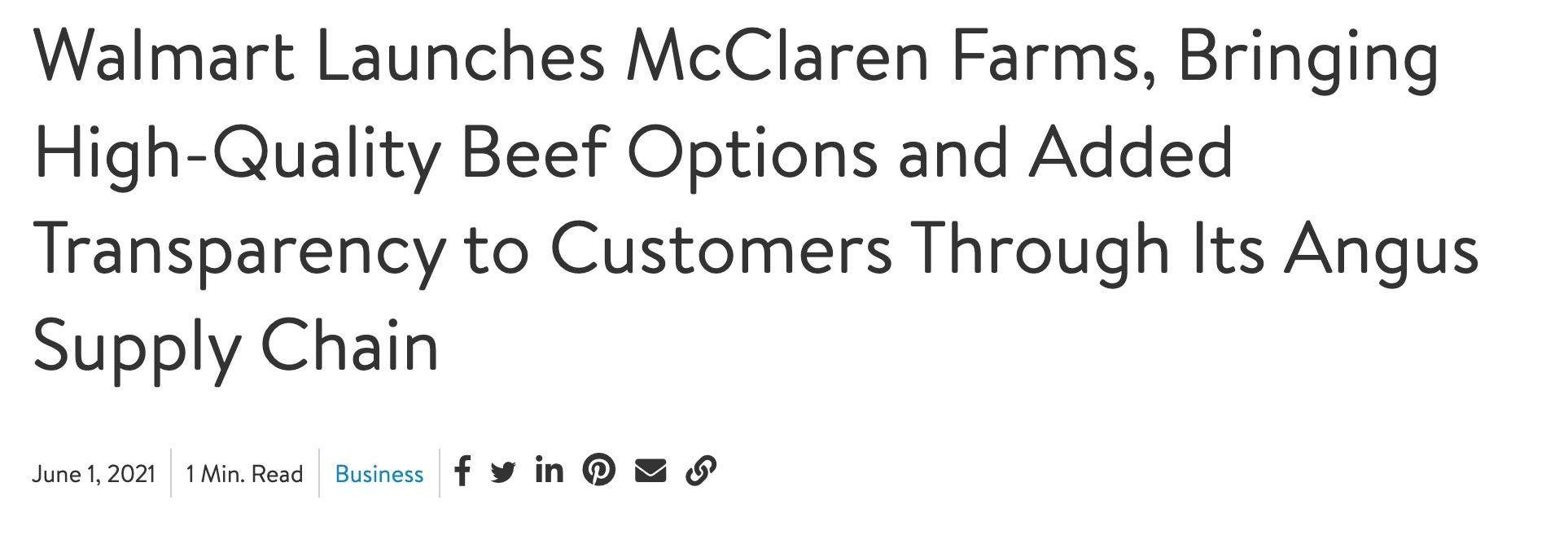Walmart: 800 Pound Gorillas Make Really Weird Dance Partners

In 2019, the now $371.4 billion market cap retailer announced that they were tired of being treated like the red-headed stepchild by major beef packers and being the grocery store that shoppers went to for everything except beef. Walmart had decided to do something about it. It was time to level up:

In 2021, Walmart announced the launch of its premium fresh beef brand in 500 stores across the southeastern US, McClaren Farms:

In 2022, Walmart announced this:

A lot of folks say the minority investment in Sustainable Beef is a game changer.
I disagree.
It's interesting, but it’s nothing more than an incremental continuation of their current strategy. Not a shift, certainly not a game changer.
A Walmart minority investment in a slaughter plant makes sense given its recent investment in the supply chain behind its McClaren Farms brand, including the acquisition of a case-ready plant.
But if Walmart were serious about beef processing, they'd build/buy their own slaughter plant. Not make a minority investment in someone else's.
Today we look at why this minority investment is not a big deal, future potential moves Walmart might make that would be a big deal, and wargame how packers and other retailers might respond.
First, let's look at the scale of Walmart's retail beef business.
In the US, 2021 fresh beef sales at retail were $30.1 billion. And in 2021, Walmart had 18% of US grocery market share. Using rough math we can estimate Walmart beef sales at $5.1 billion. Given Walmart's efforts to improve the quality of fresh beef sold in their stores to increase per pound revenue AND volume, let's say they're targeting $8 billion in beef sales by 2025. Whether they hit that or not, this is not a tiny business.
But the bigger impact on the Walmart P&L might be from the 'basket lift', or the increase in the total spend, when a shopper buys beef. I don't have any idea whether that number is .25% or 25% or anywhere in between. But safe to say that when applied across Walmart's scale, it represents meaningful revenue.
Now contrast those beef numbers with the dairy case, specifically looking at fluid milk. Total 2021 US retail fluid milk sales were estimated at $12.6 billion so an estimated Walmart share is $2.3 billion.
Yet in 2016 Walmart announced it would be building its own milk processing plant in Indiana.
Milk is a much smaller business than fresh beef, yet Walmart opted for total control. That’s one reason my hypothesis is:
If Walmart were serious about beef, they would be buying or building their own kill plant.
Unless this minority investment is a precursor to a bigger move, the baby step before the monumental leap.
Let's assume Walmart has learned a lot in the last few years from their McClaren Farms aligned supply chain, working with 44 Farms to source Angus genetics and maintain alignment from cow-calf to feedyards to slaughter at Creekstone Farms to final processing at the Walmart case-ready plant operated by FPL Foods.
Contrast that with the supply chain for the remainder of their beef that is NOT McClaren Farms brand. That supply chain, from a Walmart perspective, is both simple and standard for a retailer: buy meat from the packer. Easy as pie.
With a few years of McClaren Farms learnings under their belt, let's assume the Walmart team has learned A LOT about aligning incentives, navigating industry fragmentation, the challenges of managing a complex biological system, managing costs through the supply chain, and more.
So it makes sense that the minority investment in a slaughter plant is another step in that journey both to scale and expand the McClaren Farms brand beyond the 500-store pilot, AND to continue learning in order to inform Walmart’s future strategy to continue elevating and differentiating its fresh beef offering.
Just for fun, let's play out some possible scenarios. What might Walmart's presence in the beef industry look like in 5-10 years?
1. Status Quo. Slowly grow the new McClaren Farms supply chain in & beyond the current 500 stores. Possible.
2. Decelerate. Walmart exits Sustainable Beef, exits case-ready plant, winds down McClaren Farms brand. Possible but unlikely.
3. Accelerate. Walmart decides that beef is as strategically central to its future in food retail as the rotisserie chicken is to Costco’s strategy, and echoes Costco’s decision to build a rotisserie chicken plant by buying/building a wholly owned Walmart beef slaughter plant. Highly likely, IMO.
Let’s say Walmart purchases or builds a beef slaughter plant in the next 3-5 years. How would Walmart's suppliers respond? What about retail competitors?
Let’s briefly wargame this from 3 angles:
• What Sustainable Beef might do if Walmart bought/built a plant
• What the big 4 packers might do (Cargill, JBS, Tyson, National Beef)
• What other retailers might do (Kroger, Albertson’s, Amazon)
Let’s start with Sustainable Beef. Perhaps a Walmart acquisition is the likely exit strategy for early investors in Sustainable Beef. We recently talked about the criticality for these upstart plants of building a consistent customer base for carcass balance and revenue maximization, so let’s assume that Walmart is that anchor customer in the short run. So one scenario is that Walmart as anchor customer gets the plant to full utilization, and then if the business proves successful, Walmart buys out the other investors. That’s potentially a great outcome for those investors.
But also, there’s a risk that Walmart uses both the relationship with Sustainable Beef, and the insights gained from that relationship, as leverage with their other packer suppliers. Those other packer suppliers also happen to be the companies who, over the long term, are better positioned to be supplier partners to Walmart than Sustainable Beef because of their scale and diversity of capability.
The kicker is that if the McClaren Farms brand only sells into 500 stores today, that’s only a fraction of the total beef Walmart needs to source. The rest comes from the big 4.
So now that Walmart is a minority owner in Sustainable Beef, Walmart is both customer and quasi-competitor to the large processors.
This is messy stuff. You can’t ignore Walmart, it is definitely the 800 lb gorilla of beef retail customers. In this case, you have to dance with the 800 lb gorilla, but wow is it an awkward dance if you are both its competitor and supplier.
So what would the big packers do if Walmart went all in to buy or build a plant? I don’t have a good guess here. I’d love to hear from meat industry folks, because my best guess is that there wouldn’t be much response. It’s very impractical to think Walmart could process enough cattle to supply 100% of its beef supply, particularly when you take into account the cuts that Walmart sells in its meat case. So you would still have the packers as both customer & competitor, only in a more extreme scenario.
And what about other retailers? Would Kroger or Albertson’s follow suit? Would this be what drove Amazon into the packing business? I can see these players trying to replicate the aligned supply chain of McClaren Farms, or even buying their own case-ready plants. But I’m skeptical that it would make sense for any other retailer to make a move into slaughtering cattle given the necessary scale.
And then there are the known unknowns that could impact future Walmart decisions like how the macro environment might change from inflation to interest rates, how the cattle cycle moves, or how capital markets move. And whether in a few years the upstart plants breaking ground now are being sold as those operators realize the challenges of starting & running a beef processing plant (see Prime Future 114 below).
And then there are the unknown unknowns, the next black swan that either pushes Walmart further upstream or pulls them back to their safe space at retail.
That's a lot of unknowns. But the one thing we know for sure is that Walmart is the 800-pound gorilla of the retail meat case. And that gorilla won’t be ignored.
What a time to be alive.
Janette Barnard writes the Prime Future newsletter, with the goal of elevating the conversation about trends and opportunities for meaningful innovation in the animal protein value chain. She can be reached at https://primefuture.substack.com







